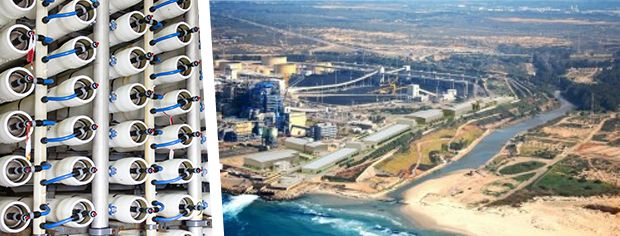Lowering Desalination’s Energy Footprint
Published on by Water Network Research, Official research team of The Water Network in Business
One place we could look to for ideas for lowering desalination's energy footprint is Israel, which relies heavily on desalination to meet its needs.

Cutting desal costs in Israel
Sixty percent of Israel is desert, and the rest is semiarid. The harsh, dry climate means ensuring water supplies is a top priority, and as a result Israel gets up to 75 percent of its potable water from desalination.
To put that into perspective, the entire state of Texas currently produces about 123 million gallons per day with desalination, or roughly 465,606 cubic meters per day. The Sorek Desalination Plant outside Tel Aviv, one of many in the country, alone produces about 624,000 cubic meters per day/ 164 MGD.
I recently toured the Sorek plant, the largest desal plant in the world, which provides about 20 percent of Israel’s potable water. One of the things that struck me, other than the sheer size, was how energy was a front-and-center concern. Since desal plants need constant power – and a lot of it – energy is by far the most expensive part of running the plant.
Groundwater desal is highly energy-intensive, and seawater even more so – power is estimated at about half of seawater desal plants’ entire operating costs.
Three tactics help ease these costs and maintain plant reliability:
- On-site power generation : Two of the other biggest plants in Israel are located next to power plants, which means less energy lost during transmission and distribution, as well as greater reliability. One of those, Hadera, is located near a gas-fired power plant, which requires significantly less water than coal. Israel could further cut desal’s water footprint by installing no-water resources like wind turbines or solar panels on-site.
- Energy efficiency : Israel is home to the two most energy-efficient desal facilities in the world: Hadera and Sorek, respectively. Sorek looks to reduce its energy consumption at every step of the process, like its energy recovery system, which captures energy from the brine stream that would have otherwise been wasted and uses it to power pumps. Unfortunately, U.S. desal plants tend to be behind the tech curve because the approval process takes so long. With a robust, more streamlined approvals process and newer technology, American plants could maximize efficiency as Israel does.
- Taking advantage of smart pricing : Israel has variable electricity rates, meaning they change depending on the season, day of the week, and time of day. Sorek negotiated a lower electricity rate in exchange for participating in the demand response program – in this case, agreeing to do the most production at night when both electric demand and prices are lower. In fact, Sorek was built to be responsive to peak demand: It can change its operating capacity from 30 to 120-percent production in less than five minutes, in response to the electricity rate. Moreover, by enabling customers to alter their energy-use based on peak demand and pricing, Israel’s entire electric grid benefits from greater stability. Leveraging demand response could help desalination in Texas and other states that deal with drought, like California, be more energy- and water-efficient.
Blog by: Kate Zerrenner
Read full blog on: Environmental Defense Fund
Media
Taxonomy
- Energy
- Energy Efficiency
- Desalination
- Operation & Maintenance
- Sea Water Filtration
- Sea Water Desalinisation
- Sustainable Desalination
- Operations
- Desalination Plant
- Energy-Water Nexus
- Desalination
1 Comment
-
Very good performance.....